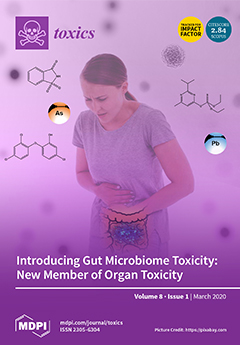Environmental exposure to moderate-to-high levels of cadmium (Cd) and lead (Pb) is associated with nephrotoxicity. In comparison, the health impacts of chronic low-level exposure to Cd and Pb remain controversial. The aim of this study was to therefore evaluate kidney dysfunction associated with chronic low-level exposure to Cd and Pb in a population of residents in Bangkok, Thailand. The mean age and the estimated glomerular filtration rate (eGFR) for 392 participants (195 men and 197 women) were 34.9 years and 104 mL/min/1.73 m
2, respectively, while the geometric mean concentrations of urinary Cd and Pb were 0.25 μg/L (0.45 μg/g of creatinine) and 0.89 μg/L (1.52 μg/g of creatinine), respectively. In a multivariable regression analysis, the eGFR varied inversely with blood urea nitrogen in both men (β = −0.125,
p = 0.044) and women (β = −0.170,
p = 0.008), while inverse associations of the eGFR with urinary Cd (β = −0.132,
p = 0.043) and urinary Pb (β = −0.130,
p = 0.044) were seen only in women. An increased urinary level of Cd to the median level of 0.38 μg/L (0.44 μg/g of creatinine) was associated with a decrease in the eGFR by 4.94 mL/min/1.73 m
2 (
p = 0.011). The prevalence odds of a reduced eGFR rose 2.5-, 2.9- and 2.3-fold in the urinary Cd quartile 3 (
p = 0.013), the urinary Cd quartile 4 (
p = 0.008), and the urinary Pb quartile 4 (
p = 0.039), respectively. This study suggests that chronic exposure to low-level Cd is associated with a decline in kidney function and that women may be more susceptible than men to nephrotoxicity due to an elevated intake of Cd and Pb.
Full article






